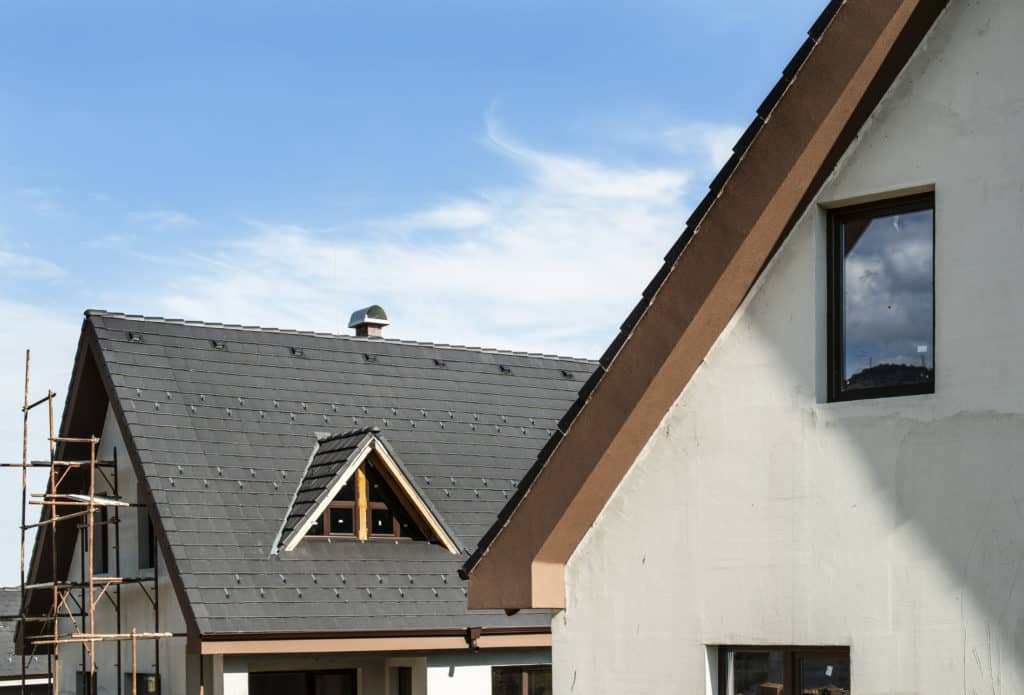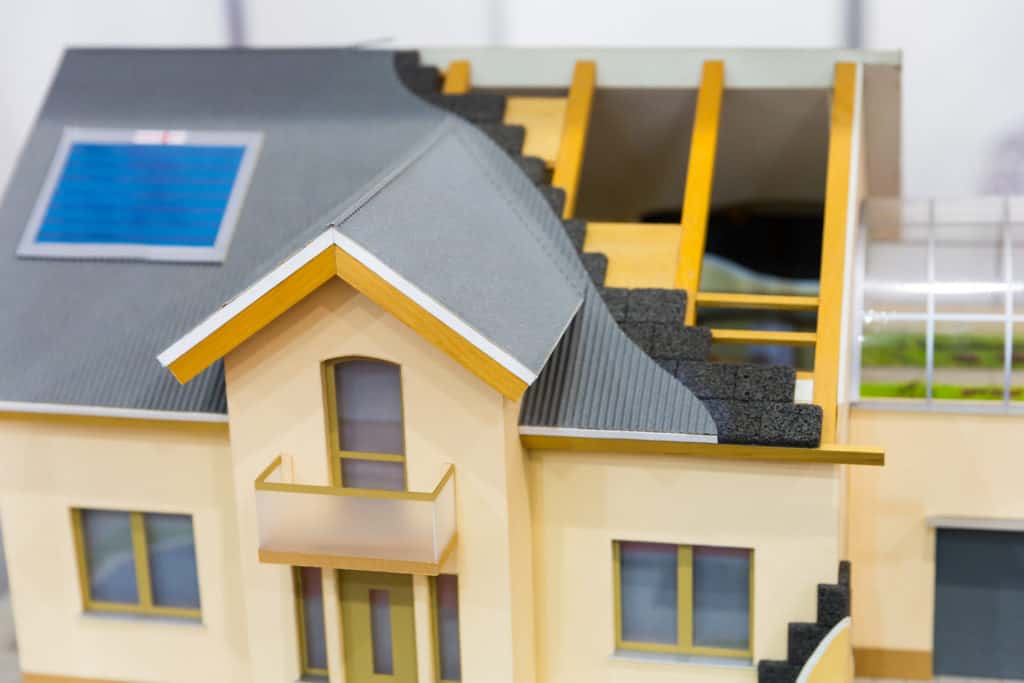The roof protects your home from harsh weather but can also increase your energy bills if it’s not energy efficient. For example, if your home is located in an area without much shade, the roof will be exposed to the sun for long hours. This can overwork your HVAC system and drive up your energy bills. If you want to lower your energy costs, there are several ways to make your roof more energy efficient.

Light-colored roofing materials
If you plan to install a new roof, it’s essential to consider energy efficiency. Light-colored roofing materials are usually more energy-efficient than darker ones. They have higher reflectivity ratings, keeping your home cooler in warmer weather.
There are many factors to consider when determining the best roofing material for your home. In addition to higher reflectivity, lighter roofs have better ventilation and insulation. Proper ventilation is critical to preventing moisture and heat buildup in your attic. Proper insulation will help keep outdoor air out while keeping the air inside. While energy efficiency is essential, it can be overwhelming.
Darker roofs rarely have higher energy efficiency than light ones, although some homeowners find that dark roofs reflect heat better. Choosing a material with the right solar reflectance index and heat retention capabilities is critical to making your roof energy efficient. This can be achieved by installing a cool-roof solar reflective coating, which can be applied to almost any roofing material.
Choosing light-colored roofing materials can help reduce the urban heat island effect, a problem in many urban settings. Urban heat islands make it hotter inside, increasing air pollution and health problems and straining energy resources. It also contributes to global warming. Light-colored roofing materials can also improve the service life of your roof by reflecting heat. Dark-colored roofs are more susceptible to UV rays, which can damage materials and cause them to crack, blister, and fade.
Light-colored roofing materials can help prevent snow from accumulating on your roof in cold climates, but it’s essential to consider the climate before installing a dark-colored roof. If you live in a climate with mild winters, a dark-colored roof is energy efficient, while dark ones absorb heat. In warmer climates, light-colored roofing materials can reflect heat and reduce energy usage.

Attic insulation
Adding attic insulation is one way to improve the energy efficiency of your roof. It can help keep your home heated and comfortable in the colder months. While batts are available in various thicknesses, it is more effective to use 6-mil polyethylene sheeting, which can be cut to fit between joists and seal seams with foil tape.
The attic space of most homes is larger than the finished space inside the home, making it a prime location for heat exchange. In the summer, hot air rises into the attic and traps heat. This trapped heat makes the top portion of the home too warm and causes moisture to build up on the roof, damaging its shingles. Adding insulation will prevent moisture buildup and help keep the attic at a consistent temperature.
Before you start insulating your attic, it is essential to measure it. This will allow you to determine how much insulation you need. Fiberglass, for example, won’t irritate your skin or lungs, but it can be more expensive than other types of insulation. If you’re considering installing attic insulation, you should hire a contractor. While homeowners can attempt this job independently, they might not be familiar with the necessary safety measures and equipment. Also, homeowners may make mistakes that are costly to repair.
Proper installation is critical to ensuring proper insulation. Ensure that the insulation is installed uniformly and that the depth of each layer is the same. You can use depth guides to help with leveling the material.
Cool roof solar reflective coating
If you want to make your roof more energy efficient, you can apply a cool roof solar reflective coating. The solar reflective index of cool roof coatings is high, reducing heat access and keeping the interior of the house cooler. These coatings are made of unique materials, including highly reflective pigments and nano insulation. They also have excellent waterproofing properties. Some types of cool roof coatings are even water-based, which makes them a green option. Other types of cool roof coatings are acrylic-based and contain unique glass pigments, microfibers, cross-linking polymers, and advanced antifungal additives.
An excellent roof coating will reduce energy costs by reflecting the sun’s heat away from your home. Depending on the type of coating and the location of your home, you can expect savings ranging from 20% to 70%. The benefits of an excellent roof coating vary based on the shape of your home, how reflective it is, and whether you use air conditioning.
Cool roof coatings can be made of white, gray, or any other color that will reflect the sun’s rays. These roof coatings are made to reflect at least 80% of solar energy. The pigmented coatings are more appealing and may reflect as little as 20% of the solar heat. Aluminum-coated roofs can reflect 50% to 70% of solar heat. Alternatively, you can choose a solar-reflective coating with aluminum flakes embedded in the resin.
You must install an excellent solar reflective coating to make your roof energy-efficient. These roof coatings have high solar reflectance and high infrared emissivity. The higher the SRI, the cooler your roof will be in the sun.

Skylights
Adding skylights to your roof is a great way to make your home more energy efficient. A skylight can give any room a dramatic feel by allowing natural light. However, you must select the proper placement to maximize energy savings. Typically, skylights should be placed on the south-facing slope of the roof for the best energy efficiency. Alternatively, in a temperate climate, you can place your skylight on the north-facing slope.
While heat loss during winter isn’t as bad as in summer, choosing the right location for your skylight is still a good idea. North-facing roof sections will limit the amount of sunlight that enters the room, so placing the skylight higher up on the roof will allow it to travel a longer shaft.
A solar-powered “fresh air” skylight is another option for homeowners who don’t want to deal with wiring. This type of skylight has a solar panel and is controlled via remote control or an app. There are even ENERGY-STAR-qualified skylights available for various climates.
In addition to helping you cut your electric bills, a skylight on your roof can make your home more comfortable. It adds natural illumination to the darkest rooms of your home and reduces your need for artificial lighting. The benefits of adding skylights to your roof include the luxury of a luxurious master bath.
The Federal Government is increasingly encouraging green energy living, and several tax incentives can help you save money. For example, the Emergency Stabilization Act of 2008 and the American Recovery and Reinvestment Act of 2009 offer up to 30 percent tax credits. By installing a solar electric property, you will receive a tax credit equal to 30 percent of your initial cost, which can significantly lower your energy bills. Make sure you consult with your accountant to ensure that you can take advantage of these incentives.
Green roofs
Green roofs help reduce energy costs by absorbing heavy rain’s weight and providing an extra layer of insulation. They also decrease carbon emissions and can improve air quality. In New York City alone, more than seven hundred buildings are equipped with green roofs and 60 acres of rooftop space. Green roofs can help reduce energy bills and equipment costs and improve the longevity of roofing membranes. They can also qualify for tax rebates.
Green roofs can help reduce the impact of the urban heat island effect. The vegetation on these roofs absorbs solar radiation and evaporative moisture, which reduces the roof’s temperature. The process is called evapotranspiration and allows for a more comfortable indoor temperature.
In addition to being energy efficient, green roofs can reduce noise and stormwater runoff. They can also help reduce the urban heat island effect’s impact and even help fight depression. A green roof will increase the value of your property. The installation cost will vary depending on the growing medium type, the plants, and the building size.
Green roofs can dramatically reduce energy costs. They can limit the heat flux in a building by up to 72 percent and provide insulation. Another benefit is that they can significantly extend the life of your roof. Their multi-layered nature also protects the inner layers of the roof membrane from harmful UV rays.
Green roofs also help reduce greenhouse gas emissions. By absorbing light that would otherwise become heat, green roofs reduce the amount of energy used to cool buildings. This reduces energy bills for both heating and cooling. Moreover, they improve indoor comfort and reduce the stress of heat waves.



